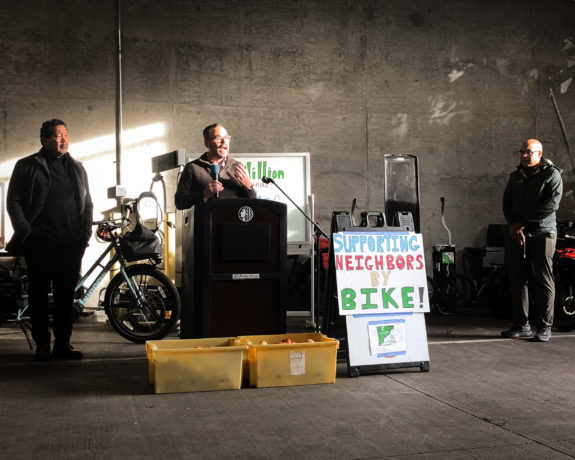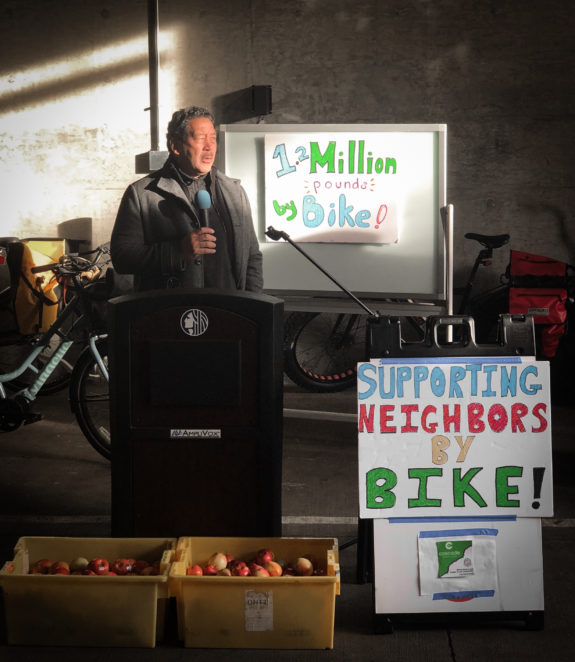
Volunteers for the Pedaling Relief Project have hauled 1.2 million pounds of food by bike since 2020, all to support local food bank operations. That’s equivalent to about 1 million meals.
“It helps us and the other food bank partners achieve their mission at a time when volunteerism is not keeping pace with the growth in need for our services,” said U District Food Bank Executive Director Joe Gruber of the Pedaling Relief Project during a celebration press event Friday morning. “They’ve responded to our need for more volunteers creatively and thoughtfully.”
Seattle Bike Blog has been cheerleading for Maxwell Burton and the Pedaling Relief Project since the start, and I am amazed by the sheer volume of volunteer power people bring to this effort every week even years later. It’s a really cool thing to be part of, and everyone should be proud of their contributions. To join a Pedaling Relief Project team, check out their online schedule. They currently partner with the U District Food Bank, Byrd Barr Place Food Bank, the ACRS Food Bank, White Center Food Bank, and Food Not Bombs. Cargo bikes are of course welcome, but they also have trailers that are compatible with almost any bike. The Pedaling Relief Project and Seattle Bike Blog are also teaming up to produce Cranksgiving November 18.
By using bikes, volunteer riders across the area have prevented about 18,000 pounds of carbon from being released into the atmosphere, all while having fun, building community, and helping to put food on people’s tables. “We believe we are the largest carbon-free food delivery program in the country,” said Cascade Bicycle Club Executive Director Lee Lambert, “and I’ll keep saying that until I’m proven wrong.” He said he hopes to see communities across the country copy their model.
Mayor Bruce Harrell said he felt “giddy” during the event, praising the project as “a perfect alignment of what makes this city great.” The project “has taken the best of our values, environmental sustainability, thinking about those who are most vulnerable…and put them together.”

The mayor also said that the project demonstrates “the multi-benefits of having a good, safe bicycle system,” and said that when discussing transportation issues, “our common denominator has got to be safety.” He even made a reference to an often-cited quote of his from a TV debate during the mayoral race in which he said, “I don’t lead with bikes.” This time, he said, “I’m going to lead with safety.” Especially since hiring Greg Spotts as SDOT Director, the city has been making a significant effort to complete many of the bike network improvement projects that had been delayed. Harrell’s administration also has not given in to pushback against difficult bike lane efforts like the Eastlake Ave bike lanes, and Harrell’s SDOT even played hard ball with the Missing Link appellants to negotiate a deal to pave over the railroad tracks under the Ballard Bridge where many people have injured while biking. These are not easy wins, and they demonstrate that the mayor is willing to invest resources and political capital into making bike safety improvements.
2024 will be the most important year for Seattle transportation this decade as the city must decide what kind of transportation funding measure to put in front of voters and then must get that measure approved on the (likely) November ballot. So this positive dynamic between safe streets advocates and the mayor is encouraging because they will both be vital in passing a successful and ambitious funding measure. We’ll also need a supportive City Council, the majority of which is up for election right now.






